
|
ED'S OUTDOOR PAGES
(fomerly the Green Mountain Club Montpelier Section website ) |
|
|
Life-cycle of the Monarch Butterfly Text & Images © Edward Loewenton 2006 All rights reserved Page 1 Page 2 Page 3 Page 4 Page 5 |
||
|
|
||
|
2006 was a good summer for Monarch butterlies in Morrisville,
Vermont. It has been a few years since we have seen so many.
Monarchs migrate between summers in the Northern states, including
Vermont, and central Mexico, where they cluster in
great numbers during the Northern winter. |
|||
|
The
milkweed sap makes the caterpillars taste bad, so they are protected from
predators such as birds. Monarch laying eggs on a milkweed plant |
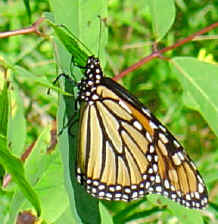
|
||
| Monarch Caterpillars (or Larvae) eat great quantities of milkweed leaves. They hatch from small white eggs attached to the leaves, and eat until they are active crawlers up to 2.5 inches long. In the process, they outgrow and shed their skin several times. The caterpillar eats its own shed skin. While devouring the milkweed, they leave large quantities of dark green droppings. |

|
||
|
The head is the end with the long antennae (the
"real" ones). At the other end are a pair of fakes, another
protective device which directs a predator's initial attacks to the less
vulnerable rear end, allowing the caterpillar to escape. When the caterpillar has eaten for 1 to 2 weeks and grown large enough, it finds some object other than a milkweed plant to attach to, so it can become a Chrysalis (pupa), inside which it will be transformed into a butterfly. |
|||
| The caterpillar attaches its tail with a very strong adhesive to the underside of whatever object it has found. There seems to be no rule about where it will crawl to, what it will select, or exactly how high it will climb, although I have not seen one higher than about 4 feet. I have found them on a cauliflower plant, a low tree branch, a seed spreader, and a garden hose faucet. |
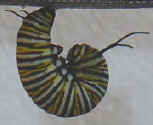 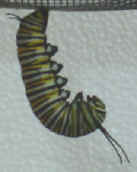
|
||
|
The larva sheds its skin one last time, rolling it from the head upward towards the tail. It drops the skin in a sort of "donut" shape (photo Pupa 4). Underneath its new shape is starting to form. The part that will be the wings can be seen in photos 1 & 2. This process occurs very quickly once it starts. |
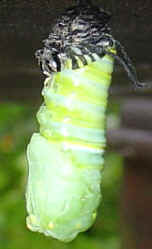
Pupa - 1 |
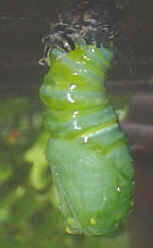 Pupa - 2 |
|
|
The chrysalis is initial very liquid and soft; the outer skin soon dries and hardens, and the outlines of the butterfly become visible. Metallic golden spots, of unknown purpose and origin, form on the surface. Their chemical makeup appears to derive from substances in the milkweed plant. |
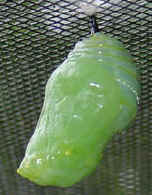 Pupa - 3 |
 Pupa - 4 |
|
|
Over a period of about 10 days, the butterfly forms inside the shell of
the chrysalis, and the covering turns from green to transparent. The
familiar orange and black colors of the soon-to-emerge butterfly can be
seen. When the transformation is complete, the butterfly emerges. This process occurs rapidly. Seams along the top of the chrysalis start to open, and then the entire shell starts to break apart. |
 
|
||
|
(Next: emerging butterfly) Page 1 Page 2 Page 3 Page 4 Page 5 ED'S OUTDOOR PAGES and list of Trip Reports
|
|||